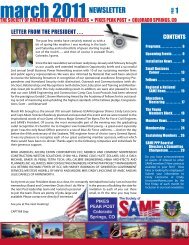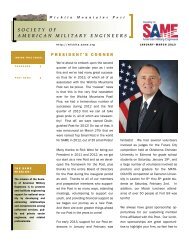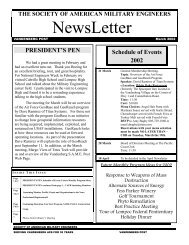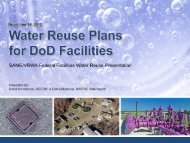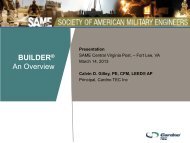Small Business Liaison Officer Training
Small Business Liaison Officer Training
Small Business Liaison Officer Training
Create successful ePaper yourself
Turn your PDF publications into a flip-book with our unique Google optimized e-Paper software.
<strong>Small</strong> <strong>Business</strong> Participation and<br />
Administration of Subcontracting Plans<br />
Stephanie Lewis<br />
<strong>Small</strong> <strong>Business</strong> Administration<br />
Office of Govt. Contracting
<strong>Small</strong> <strong>Business</strong> Participation<br />
Federal Contracts > Simplified Acq. Threshold<br />
($150,000)<br />
FAR 52.219-8 Utilization of <strong>Small</strong> <strong>Business</strong> Concerns<br />
Applies to Large and <strong>Small</strong> prime contractors<br />
“Maximum practical utilization”of small business concerns as<br />
subcontractors<br />
Federal Contracts > $650,000 (or $1.5 million for<br />
construction)<br />
FAR 52.219-9 <strong>Small</strong> <strong>Business</strong> Subcontracting Plan<br />
Applies only to Large businesses.
Subcontracting plans are not required<br />
(FAR 19.702)...<br />
From small business concerns<br />
For personal services contracts<br />
For contracts performed exclusively outside the United<br />
States<br />
When there will be no subcontracting whatsoever<br />
Self-performing entire contract and no materials purchased<br />
.
Subcontracting Plan in Contract Award<br />
Failure to submit and negotiate the subcontracting plan shall<br />
make the offeror ineligible for award of a contract<br />
FAR 52.219-9(c)<br />
Subcontracting plan should be negotiated before award<br />
FAR 19.705-2(d) and -4(b) and (c)<br />
Becomes a part of the contract award document
Content of Subcontracting Plans<br />
State goals for SB, SDB, WOSB, HUBZone SB, VOSB, and SD-<br />
VOSB<br />
Contain both dollar and percentage goals<br />
Establish base and option year goals separately<br />
Fully explain what items will be subcontracted and from what<br />
size business<br />
Explain good faith efforts going to put forth to involve small<br />
businesses in each size category<br />
Agree to flow down the subcontracting plan requirement in<br />
subcontracts over the threshold<br />
A contract can only have one subcontracting plan
Good Faith Efforts<br />
Break apart orders into feasible units<br />
Conduct market research to identify small business<br />
subcontractors and suppliers through all reasonable means:<br />
search on the Central Contractor Registration/Dynamic <strong>Small</strong><br />
<strong>Business</strong> Search<br />
Post notices of Sources Sought and/or Requests for Proposal on<br />
SBA’s SUB-Net<br />
Participate in <strong>Business</strong> Matchmaking events and attending prebid<br />
conferences;
Good Faith Efforts<br />
Solicit small business concerns as early in the acquisition process as<br />
practicable to allow them sufficient time to submit a timely offer for<br />
the subcontract<br />
Provide interested small businesses with adequate and timely<br />
information about the plans, specifications, and requirements for<br />
performance to assist them in submitting a timely offer<br />
Negotiate in good faith with interested small businesses<br />
Direct small businesses that need additional assistance to SBA<br />
Utilize the available services of small business associations, and local<br />
small business assistance offices, and other organizations<br />
Participate in a formal mentor-protégé program with one or more<br />
small-business protégés that results in developmental assistance to the<br />
protégés.
Who Approves the Subcontracting<br />
Plan?
Subcontracting Plan Approval<br />
Offeror sends it to the Contracting <strong>Officer</strong><br />
Contracting <strong>Officer</strong>s route each plan to the agency’s<br />
<strong>Small</strong> <strong>Business</strong> Specialist and the SBA Procurement<br />
Center Representative (PCR) for comments<br />
Check for realistic goals and required elements of the<br />
plan.
Types of Subcontracting Plans
Four Types of Subcontracting Plans<br />
1. Individual Subcontracting Plan<br />
Contains all the required elements of a subcontracting plan, including<br />
goals, for one federal contract. Remains the same for the life of the<br />
contract (unless it is modified and approved by the Contracting <strong>Officer</strong>).<br />
2. Master Plan<br />
Appropriate for companies that submit lots of plans.<br />
Boiler plate: contains all the required subcontracting plan elements except<br />
for goals and the rationale used to develop goals.<br />
Goals and rationale are developed on a contract by contract basis.<br />
Good for a three year period
3. Commercial Subcontracting Plan<br />
Preferred type for offers supplying a Commercial Item to the Govt.<br />
Applies to production of both commercial and non-commercial products rather<br />
than solely for one Government Contract.<br />
Annual plan based on the contractor’s fiscal year<br />
Can be company-wide or division-wide, plant-wide, or based on product line<br />
Approved by the agency awarding the first federal prime contract<br />
Subsequently approved by the Contracting <strong>Officer</strong> with the contract that has the<br />
furthest completion date
4. DoD Comprehensive Test Subcontracting<br />
Program (Comp Plan)<br />
Subcontracting plan set forth annually that covers all DoD<br />
subcontracting for the govt. fiscal year<br />
Negotiated annually with DCMA<br />
Two target SDB categories<br />
Non DOD contracts must still have Individual/Commercial<br />
Plan<br />
Comp Plan participants:<br />
www.acq.osd.mil/osbp/programs/csp/index.htm
Subcontracting Plan<br />
Reporting - www.esrs.gov
Reporting Requirements: Individual<br />
Subcontracting Reports (ISRs)<br />
For Individual Subcontracting Plans (Not required for<br />
Comprehensive or Commercial Plans)<br />
Due semiannually -- for the periods ending March 31 and September<br />
30, and at contract completion<br />
Used to determine if subcontracting plan goals are being<br />
met.<br />
Report goals from subcontracting plan and subcontracts<br />
placed since inception of the contract.
ISR Entry Preparation (prime)<br />
Agency must have entered your prime contract into<br />
FPDS<br />
As a prime contractor you will need:<br />
Your DUNS number used to bid on the contract<br />
Product/Service Code (describes what is being purchased)<br />
Contract NAICS code<br />
The prime contract number<br />
Current contact value<br />
A copy of your approved subcontracting plan<br />
Email address of the federal government agency responsible<br />
for reviewing your report
ISR Entry Preparation (sub)<br />
As a subcontractor to a higher tier prime contractor, you will<br />
need:<br />
The prime contract number<br />
The subcontract number<br />
The DUNS number of the contractor that awarded you the<br />
subcontract<br />
Product/Service Code required by the subcontract<br />
Subcontract NAICS code<br />
A copy of your approved subcontracting plan<br />
Email address of the individual responsible at the higher tier<br />
contractor responsible for reviewing your report
ISR Entry Steps<br />
Enter prime contract number<br />
Indicate if you are a prime contractor or subcontractor
ISR Entry<br />
Based on the prime contract number, the system is going to<br />
populate several fields:<br />
DUNS<br />
Contractor’s Name Address<br />
Agency Awarding the contract<br />
Product/Service Code & NAICS Code<br />
Current Contract Value<br />
Ultimate Contract Value<br />
Any errors must be corrected by the Contracting <strong>Officer</strong> in<br />
FPDS
ISR Entry: reporting period
Enter goals and achievements to<br />
date
Reporting Requirements: Summary<br />
Subcontract Report (SSR)<br />
For Individual/Master/Comprehensive Plans:<br />
Due semiannually for DoD and NASA contractors<br />
Due annually for civilian contractors, except NASA<br />
for the periods ending March 31 and September 30.<br />
For Commercial Plans<br />
Due Annually for the period ending September 30
SSR entry in eSRS<br />
Format similar to ISR input<br />
No goals – just input subcontracts awarded during reporting<br />
period<br />
Submitted on a corporate, company or subdivision basis<br />
Enter all subcontracts awarded under any prime or<br />
subcontract with that agency for 6 month (if required) and<br />
one year period<br />
Not cumulative like the ISR<br />
Not a sum of the company’s SF 294 reports<br />
(because the SF 294 is from inception of contract and SF 295 is for a 6<br />
month or one year reporting period)
SSR Reports<br />
Always includes indirect costs<br />
Do a separate SSR for every agency you one or more<br />
subcontracting plans with (DoD is one agency except<br />
construction: broken down by DOD component).<br />
Except for commercial plan-holders: state percentage to each<br />
agency on the same SSR report<br />
You must certify that the CEO has approved the SSR<br />
Required to retain a copy signed by the CEO on file
SDB Report<br />
Separate report in eSRS<br />
Due Annually for the period ending September 30<br />
Subcontracts awarded to SDBs for the year, broken out by<br />
NAICS code<br />
due by Dec 31 st each year
SBA Contacts<br />
Stephanie Lewis (North and East Texas – Fort Worth)<br />
817-684-5303<br />
Stephanie.lewis@sba.gov<br />
Sophia Chou<br />
817-684-5304<br />
Shufang.chou@sba.gov<br />
Other SBA representatives:<br />
www.sba.gov/gc, Click on Contacts and Representatives







